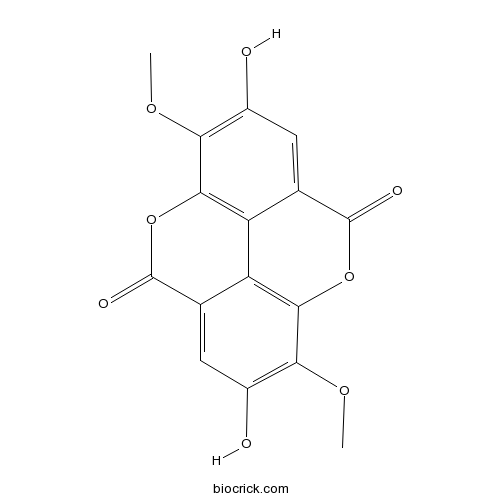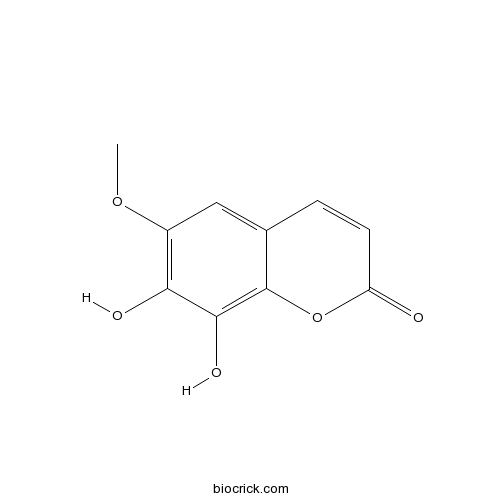Triadica sebifera
Triadica sebifera
1. The products in our compound library are selected from thousands of unique natural products; 2. It has the characteristics of diverse structure, diverse sources and wide coverage of activities; 3. Provide information on the activity of products from major journals, patents and research reports around the world, providing theoretical direction and research basis for further research and screening; 4. Free combination according to the type, source, target and disease of natural product; 5. The compound powder is placed in a covered tube and then discharged into a 10 x 10 cryostat; 6. Transport in ice pack or dry ice pack. Please store it at -20 °C as soon as possible after receiving the product, and use it as soon as possible after opening.
Natural products/compounds from Triadica sebifera
- Cat.No. Product Name CAS Number COA
-
BCN5062
3,8-Di-O-methylellagic acid2239-88-5
Instructions

-
BCN5653
Kaempferol520-18-3
Instructions

-
BCN5903
Fraxetin574-84-5
Instructions

-
BCN4226
5-Hydroxymethylfurfural67-47-0
Instructions

Impact of Field Densities of the Naturalized Defoliator Caloptilia triadicae (Lepidoptera: Gracillariidae) on the Invasive Weed Chinese Tallowtree.[Pubmed: 29029031]
Chinese tallowtree, Triadica sebifera (L.) Small (Euphoriaceae), is one of the most aggressive weeds of coastal wetlands and forests of the southeastern United States. The lack of specialist herbivores in the invaded range may be one of the factors that contribute to the invasive nature of this weed. Chinese tallowtree has been the target of a classical biological control project since 2006. Several herbivore species are being tested for biological control of Chinese tallowtree. Concurrently, an adventive herbivore, Caloptilia triadicae Davis (Lepidoptera: Gracillariidae), was found feeding on Chinese tallowtree in the southeastern United States in 2004 and now occurs throughout the invaded range. Field populations of C. triadicae from two sites caused extensive mining damage to the Chinese tallowtree leaves. The greatest damage occurred after 30 d of exposure to C. triadicae in the herbivory treatment and amounted to about 25-30 leaf mines (early instars) and leaf rolls (late instars) per plant. Insecticide-treated plants had atmost 5-10 leaf mines and rolls per plant. Despite this difference, plant growth in height, number of new branches, and leaves did not differ significantly from plants protected from herbivory. Analysis of harvested plant results suggested that, in general, herbivory had little impact on biomass. However, there was a slight reduction in trunk weights in the unrestriced herbivory treatment compared with the insecticide-treated plants. Although this study exposed experimental plants to only 60 d of herbivory, these results suggested that C. triadicae alone will not exert sufficient control of invasive populations of Chinese tallowtree. Furthermore, they indicated that continued development of biological control agents that target Chinese tallowtree are needed.
BRIEF-REPORT New set of microsatellites for Chinese tallow tree, Triadica sebifera.[Pubmed: 28387880]
Chinese tallow (Triadica sebifera) is an important crop and ornamental tree. After it was introduced into the USA, it gradually became a noxious invasive tree in south-eastern America since the middle of the 1900s. Because only six microsatellites were reported previously in T. sebifera, to better understand the genetic diversity and population dynamics of such species, we reported here 28 new microsatellite markers. For these 28 microsatellites, the number of alleles per locus ranged from 2-16. The expected heterozygosity and the expected heterozygosity corrected for sample size varied from 0.0796 to 0.9081 and from 0.0805 to 0.9176, respectively. These microsatellites will provide additional choice to investigate the genetic diversity and structure in T. sebifera.
An experimental test of the EICA Hypothesis in multiple ranges: invasive populations outperform those from the native range independent of insect herbivore suppression.[Pubmed: 28039113]
The success of invasive plants may reflect environmental differences in their native and introduced ranges including both abiotic and biotic conditions, such as release from aboveground herbivory. However, in response to these novel conditions, plants from invasive populations may have higher growth rates and lower defense levels compared to those in the native range. This may contribute to their success in the introduced range but perhaps not in the native range. Here, we grew 1000 Triadica sebifera plants from 14 native and introduced populations in seven common gardens with unmanaged background vegetation for three growing seasons in three geographic venues that varied in T. sebifera status and insect herbivore communities: Texas -T. sebifera is invasive, low levels of generalist herbivory; Hawaii - T. sebifera introduced but not invasive, high levels of generalist herbivory from exotic herbivores; China - native range, both generalist and specialist herbivores. We suppressed aboveground insects with insecticide on half the plants. Aboveground damage in the first growing season was lowest in Texas and insecticide sprays reduced damage in China. At the end of the first growing season, plants were tallest on average in China and shortest in Hawaii. However, height in later years and mass were highest on average in Texas and lowest in Hawaii. However, there was large variation in damage and plant performance among gardens within venues. Our results suggest that more rapid aboveground growth rates contribute to T. sebifera's success in both the invasive and native ranges independent of aboveground herbivory. However, strong variation among sites indicates that T. sebifera plants from invasive populations only have a strong advantage in a subset of sites in Texas.
A native plant competitor mediates the impact of above- and belowground damage on an invasive tree.[Pubmed: 27755734]
Plant competition may mediate the impacts of herbivory on invasive plant species through effects on plant growth and defense. This may predictably depend on whether herbivory occurs above or below ground and on relative plant competitive ability. We simulated the potential impact of above- or belowground damage by biocontrol agents on the growth of a woody invader (Chinese tallow tree, Triadica sebifera) through artificial herbivory, with or without competition with a native grass, little bluestem (Schizachyrium scoparium). We measured two defense responses of Triadica through quantifying constitutive and induced extrafloral nectar production and tolerance of above- and belowground damage (root and shoot biomass regrowth). We examined genetic variation in plant growth and defense across native (China) and invasive (United States) Triadica populations. Without competition, aboveground damage had a greater impact than belowground damage on Triadica performance, whereas with competition and above- and belowground damage impacted Triadica similarly. Whole plant tolerance to damage below ground was negatively associated with tolerance to grass competitors indicating tradeoffs in the ability to tolerate herbivory vs. compete. Competition reduced investment in defensive extrafloral nectar (EFN) production. Aboveground damage inhibited rather than induced EFN production while belowground plant damage did not impact aboveground nectar production. We found some support for the evolution of increased competitive ability hypothesis for invasive plants as United States plants were larger than native China plants and were more plastic in their response to biotic stressors than China plants (they altered their root to shoot ratios dependent on herbivory and competition treatments). Our results indicate that habitat type and the presence of competitors may be a larger determinant of herbivory impact than feeding mode and suggest that integrated pest management strategies including competitive dynamics of recipient communities should be incorporated into biological control agent evaluation at earlier stages.
Plant genotypes affect aboveground and belowground herbivore interactions by changing chemical defense.[Pubmed: 27623939]
Spatially separated aboveground (AG) and belowground (BG) herbivores are closely linked through shared host plants, and both patterns of AG-BG interactions and plant responses may vary among plant genotypes. We subjected invasive (USA) and native (China) genotypes of tallow tree (Triadica sebifera) to herbivory by the AG specialist leaf-rolling weevil Heterapoderopsis bicallosicollis and/or the root-feeding larvae of flea beetle Bikasha collaris. We measured leaf damage and leaves rolled by weevils, quantified beetle survival, and analyzed flavonoid and tannin concentrations in leaves and roots. AG and BG herbivores formed negative feedbacks on both native and invasive genotypes. Leaf damage by weevils and the number of beetle larvae emerging as adults were higher on invasive genotypes. Beetles reduced weevil damage and weevils reduced beetle larval emergence more strongly for invasive genotypes. Invasive genotypes had lower leaf and root tannins than native genotypes. BG beetles decreased leaf tannins of native genotypes but increased root tannins of invasive genotypes. AG herbivory increased root flavonoids of invasive genotypes while BG herbivory decreased leaf flavonoids. Invasive genotypes had lower AG and BG herbivore resistance, and negative AG-BG herbivore feedbacks were much stronger for invasive genotypes. Lower tannin concentrations explained overall better AG and BG herbivore performances on invasive genotypes. However, changes in tannins and flavonoids affected AG and BG herbivores differently. These results suggest that divergent selection on chemical production in invasive plants may be critical in regulating herbivore performances and novel AG and BG herbivore communities in new environments.
In-situ transesterification of seeds of invasive Chinese tallow trees (Triadica sebifera L.) in a microwave batch system (GREEN(3)) using hexane as co-solvent: Biodiesel production and process optimization.[Pubmed: 26638139]
In-situ transesterification (simultaneous extraction and transesterification) of Chinese tallow tree seeds into methyl esters using a batch microwave system was investigated in this study. A high degree of oil extraction and efficient conversion of oil to biodiesel were found in the proposed range. The process was further optimized in terms of product yields and conversion rates using Doehlert optimization methodology. Based on the experimental results and statistical analysis, the optimal production yield conditions for this process were determined as: catalyst concentration of 1.74wt.%, solvent ratio about 3 (v/w), reaction time of 20min and temperature of 58.1°C. H(+)NMR was used to calculate reaction conversion. All methyl esters produced using this method met ASTM biodiesel quality specifications.
Deep Sequencing of the Fruit Transcriptome and Lipid Accumulation in a Non-Seed Tissue of Chinese Tallow, a Potential Biofuel Crop.[Pubmed: 26589268]
Chinese tallow (Triadica sebifera) is a valuable oilseed-producing tree that can grow in a variety of conditions without competing for food production, and is a promising biofuel feedstock candidate. The fruits are unique in that they contain both saturated and unsaturated fat present in the tallow and seed layer, respectively. The tallow layer is poorly studied and is considered only as an external fatty deposition secreted from the seed. In this study we show that tallow is in fact a non-seed cellular tissue capable of triglyceride synthesis. Knowledge of lipid synthesis and storage mechanisms in tissues other than seed is limited but essential to generate oil-rich biomass crops. Here, we describe the annotated transcriptome assembly generated from the fruit coat, tallow and seed tissues of Chinese tallow. The final assembly was functionally annotated, allowing for the identification of candidate genes and reconstruction of lipid pathways. A tallow tissue-specific paralog for the transcription factor gene WRINKLED1 (WRI1) and lipid droplet-associated protein genes, distinct from those expressed in seed tissue, were found to be active in tallow, underpinning the mode of oil synthesis and packaging in this tissue. Our data have established an excellent knowledge base that can provide genetic and biochemical insights for engineering non-seed tissues to accumulate large amounts of oil. In addition to the large data set of annotated transcripts, the study also provides gene-based simple sequence repeat and single nucleotide polymorphism markers.


